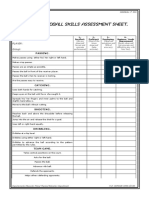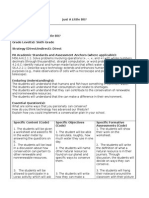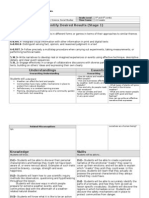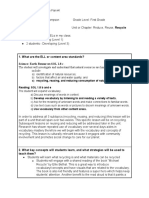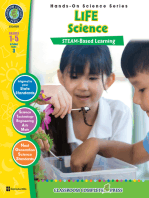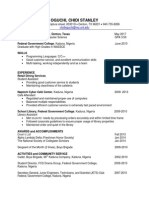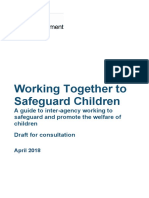Art Integration Lesson Plan Template: (Please Circle)
Art Integration Lesson Plan Template: (Please Circle)
Uploaded by
api-302379773Copyright:
Available Formats
Art Integration Lesson Plan Template: (Please Circle)
Art Integration Lesson Plan Template: (Please Circle)
Uploaded by
api-302379773Original Title
Copyright
Available Formats
Share this document
Did you find this document useful?
Is this content inappropriate?
Copyright:
Available Formats
Art Integration Lesson Plan Template: (Please Circle)
Art Integration Lesson Plan Template: (Please Circle)
Uploaded by
api-302379773Copyright:
Available Formats
Art Integration Lesson Plan Template
Art Integration Lesson Plan Template
LTC 4240: Art for Children
Lesson Title & Big Idea*: Your Impact on the World Around You (Big Idea: IMPACT)
Lesson Overview/Summary*: (This is like an abstract of the structure and procedures section) The most powerful
tool to changing the world is education. Students need to have knowledge to understand whats
going on around the world and feel passionate about issues. My goal for this lesson is to create an
understanding of ways to prevent further climate change and to be aware of consequences if we
dont, and make it child-friendly. Reading The Lorax will get my students thinking about how just
one person can have an impact their surroundings.
Key Concepts for each area (1-2 each): What you want the
students to know.*
1. Visual Art: You dont need fresh supplies to make art,
reusing items is a great way to make artwork. Also, art is
useful, not just for looking.
2. Literacy: Stories teach lessons. Every story has something
that you can take away from it.
3. Science: Our Earth is in danger and we must take action to
save it. There are so many ways that anyone can help.
Grade Level: 2
Class Periods Required:
(please circle)
1
Essential Questions (1-2)*:
1. How do people contribute damage to our environment?
2. What can we do to fix and prevent damage?
3. How can we use art to help the environment?
Lesson Objectives/Goals: (Excellent resource at http://www.teachervision.fen.com/curriculum-planning/new-teacher/48345.html?for_printing=1&detoured=1): What
you want the students to do. *
1. Visual Art: The students will be able to construct a birdhouse to serve as a reminder of how much waste we generate and
how we can reuse materials to give back to the earth.
2. Literacy: The students will be able to write about ways they can be like the Lorax and help our environment.
3. Science: Each student will build a bird feeder out of an old milk jug and a planter out of a toilet paper rolls to upcycle and
contribute back to the environment.
Grade Level Expectations (GLEs)
(3-4)
(http://dese.mo.gov/divimp0rove/curriculum/GLE/)
Visual Art (https://dese.mo.gov/college-careerreadiness/curriculum/missouri-learning-standards)
1. ): VA:Cr1.2.2a: Make art or design with various materials and
Instructional Strategies (Teachers approach to helping students
achieve learning)
Reading directions aloud for auditory learners
Pictures of the steps for visual learners
Art Integration Lesson Plan Template
tools explore personal interests, questions and curiosity.
VA:Cr2.3.2a: Repurpose objects to make something new.
VA:Pr6.1.2: Analyze how art exhibited inside and outside of
schools (such as in museums, galleries, virtual spaces, and
other venues) contribute to communities.
2. Literacy(https://dese.mo.gov/college-careerreadiness/curriculum/missouri-learning-standards)Reading Standards
for Informational Text K-5: 1. Ask and answer such questions as who,
what, where, when, why, and how to demonstrate understanding of
key details in a text. 2. Recount stories, including fables and folktales
from diverse cultures, and determine their central message, lesson,
and moral. 3. Describe how characters in a story respond to major
events and challenges.
3. (https://dese.mo.gov/college-careerreadiness/curriculum/missouri-learning-standards)Science: Scope
and Sequence-Earth materials: rocks and soil, a. observe and
describe ways humans use Earths materials (e.g. soil, rocks in a
daily life).
Scope and Sequence- All Units: a. use observations as support for
reasonable explanations. (If we cut down trees, animals will lose
homes, environment will be negatively affected). B. Use observations
to describe relationships and patterns and to make predictions to be
tested. C. Compare explanations to prior knowledge.
Content Areas Integrated*:
1. Visual Art (Inspiration Artist: Aurora Robson)She creates
sculptures out of waste to remind the public that
humans generate extensive waste. We will use recycled
materials to remind ourselves/others to cut down on
consumption.
2. Literacy: Students will hear The Lorax during read aloud
and then they will later write about what each of them
can do to save the planet.
3. Science: Students will construct bird feeders to help
bird, thus helping the food chain. They will also make a
biodegradable planter so they can plant an item in their yard
Students sit at tables, so tablemates can help
(grouping)
Lesson Structure & Procedure(s) Sequence of events of the lesson
elements. (The before, during, and after the lesson, e.g.
Engagement/Opening, Procedures, Guided Practice, Conclusion ,please be
very specific, walk me through step by step of the What of what is
happening with a rationale as to WHY you are doing this):
1. Read The Lorax to my students for read aloud to get the
students thinking.
2. Discuss why its so important to take care of the Earth.
Asking questions engages students and allows them to share
ideas with each other.
3. Brainstorm a list of ways we can help the planet. Ill then
hang this list up in the classroom as a daily reminder to leave
a positive impact on the planet.
Art Integration Lesson Plan Template
at home as a reminder of The Loraxs lesson.
Opening (Gaining Attention, what will you show, or demonstrate)*: I will
read The Lorax to my students to get them thinking about how
everyone has an impact on the world around them. Afterwards
we will discuss how this relates to ourselves and Earth.
Formative Assessment strategy: (how will you assess while the
learning is happening?)
I will monitor students progress as they work because they
4. Students will go back to their tables and gather materials
for bird feeders. Students will see how there are many old
milk jugs which demonstrates the waste that humans create.
I will have done most of the cut out already, because it may
not be developmentally appropriate for them to do so.
However, they will be in charge of decorating and doing some
cutting.
5. I will give them each a small bag of bird seed to open AT
HOME, so that way their feeder can be put to use without
making a mess.
6. The next day, students will design a biodegradable planter
using a toilet paper rolls, soil, water (from a spray bottle), and
a seed.
7. I will take a photo of each student holding their creations
to I can display the pictures, since the actual artwork will not
be displayed at school.
8. The students can take their artwork home.
9. The third lesson will have students write a response on
what they can do as an individual to help the Earth.
10. I will post their picture along with their responses on our
bulletin board outside of the classroom so the rest of the
school can learn from the students ideas.
11. Our classroom will continues work to reduce our waste
and be conscience of our energy consumption.
Closure (Reflecting Anticipatory Set, how will student share what they
learned):
Students will write a few sentences on how they will work to
save the planet. This is a way for students to show me what
they learned and how they can take action.
Summative Assessment strategy*:
Their final written response after reading the book, discussing
Art Integration Lesson Plan Template
are creating visual representations of their knowledge. The
discussion that we have post-reading is helpful to see what
students already know and what they are learning from those
around them.
it, making a bird feeder, and a planter, will reflect what they
have (or havent) learned about the environment and
sustainable living.
What student prior knowledge will this lesson require/draw upon? (what do they need to already know)
A few ways that they can be environmentally friendly. When we brainstorm a list of ideas, they should have a general
understanding of what is good or bad for our environment. They are probably aware of recycling and some other basic ideas of
being eco-friendly.
Technology Instructional and/or assistive technology incorporated into the lesson to enhance instruction and student learning
We will use the classroom SmartBoard when we brainstorm a list of ideas for helping the environment. To make this project
more green we will turn the lights off while using the board, so that we arent using too much electricity. I would also like to
use natural lighting and maybe just turn one light on while students to create art work to demonstrate ways the children can
reduce their energy consumption.
How will this lesson allow for/encourage students to solve problems in divergent ways?
Students have the opportunity to ask the teacher for help, any teachers aide (if applicable), as well as each other. This allows
them to use each other as a resource, which is an incredible tool for learning. Also, this project allows for creativity, so they
can decorate however they choose, which helps to avoid problems because it is individualized.
How will you engage students in routinely reflecting on their learning? (How will the students know they have learned something?)
Written responses as well as a class discussion will help students and the teacher to realize what the students have taken
away from this lesson.
Differentiated/Accommodations/Modifications/Increase in Rigor To help meet the needs of all learners, learning differences,
cultural and language differences, etc.
For students with ADHD, I will allow them to take a break whenever necessary. Also, if they need to stand up instead of
sitting during work, they are allowed to do so.
Students that have limited mobility or autism will be assisted by a paraprofessional in order to construct these projects.
Students that are English language learners will have access to a translation app.
I will walk students through the projects step-by-step so that students can follow along (auditory learners), as well as
having pictures of the each step on the SmartBoard, so students can follow that as well (visual learners).
The seeds are sent home with the students and peanut butter will not be provided because it is an allergy risk.
Art Integration Lesson Plan Template
Lesson Resources/References (please be very specific by providing links, authors, titles, etc.):
10 Eco Friendly Artists That Will Blow Your Mind - Eluxe Magazine. (2015, January 24). Retrieved December 1, 2015,
from http://eluxemagazine.com/magazine/eco-friendly-artists/
Biodegradable Toilet Paper Roll Seedling Pots. (n.d.). Retrieved December 3, 2015, from
http://www.instructables.com/id/Biodegradable-toilet-paper-roll-pots/?ALLSTEPS
https://dese.mo.gov/college-career-readiness/curriculum/missouri-learning-standards
Seuss, D. (1971). The Lorax. New York: Random House.
Wildlife Projects for Kids: Milk Jug Bird Feeders. (n.d.). Retrieved December 3, 2015, from http://www.greatstems.com/2013/05/wildlifeprojects-for-kids-milk-jug-bird-feeders.html
* Include this information during the Padlet/prezi/ppt presentation.
References
Silverstein, L. B. & Layne, S. (n.d.). Defining arts integration. Retrieved from
http://www.americansforthearts.org/networks/arts_education/publications/special_publications/Defining%20Arts
%20Integration.pdf
You might also like
- Handball Observation SheetDocument2 pagesHandball Observation Sheetapi-497520290100% (1)
- Waste Our World Unit Plan - GR 4Document13 pagesWaste Our World Unit Plan - GR 4api-277527531No ratings yet
- Lesson Plan 2nd GradeDocument3 pagesLesson Plan 2nd Gradeapi-285101442No ratings yet
- Recycling Lesson PlanDocument2 pagesRecycling Lesson Planapi-315487341100% (3)
- Sharing The PlanetDocument4 pagesSharing The Planetapi-147600993100% (2)
- The Lorax Lesson PlanDocument11 pagesThe Lorax Lesson Planapi-235734674100% (1)
- Art Integrated Lesson PlanDocument5 pagesArt Integrated Lesson Planapi-248641854100% (1)
- Art Unit Lesson PlanDocument8 pagesArt Unit Lesson Planapi-318122480No ratings yet
- Lesson Plan Template ltc4240Document6 pagesLesson Plan Template ltc4240api-272840272No ratings yet
- Scienceunitplanner-Threesessions FinalisedDocument10 pagesScienceunitplanner-Threesessions Finalisedapi-268951514No ratings yet
- LTC 4240 Art Integration Lesson PlanDocument6 pagesLTC 4240 Art Integration Lesson Planapi-254257614No ratings yet
- Thursday LessonDocument4 pagesThursday Lessonapi-372343626No ratings yet
- Just A Little Bit Lesson PlanDocument4 pagesJust A Little Bit Lesson Planapi-285060895No ratings yet
- Social Studies Environmental Responsibility Lesson gr1Document3 pagesSocial Studies Environmental Responsibility Lesson gr1api-260708940No ratings yet
- Raymond Kallie-Lessonplan1finalDocument4 pagesRaymond Kallie-Lessonplan1finalapi-706959969No ratings yet
- Web 2Document3 pagesWeb 2api-724260415No ratings yet
- Itec 7400 El Draft Template Su2013Document6 pagesItec 7400 El Draft Template Su2013api-324404399No ratings yet
- Itec 7400 El Draft Template Su2013Document6 pagesItec 7400 El Draft Template Su2013api-324404399No ratings yet
- Running Head: Learning Opportunity 1: Lesson PlanDocument19 pagesRunning Head: Learning Opportunity 1: Lesson Planapi-318169222No ratings yet
- Tom Gibbs Lesson PlansDocument27 pagesTom Gibbs Lesson Plansapi-260571971No ratings yet
- Natural Resources: What They Are and How We Use ThemDocument5 pagesNatural Resources: What They Are and How We Use ThemTim HerberNo ratings yet
- Differentiation LessonDocument5 pagesDifferentiation Lessonapi-248065191No ratings yet
- Sample Direct Lesson PlanDocument4 pagesSample Direct Lesson Planmbatalis1894100% (1)
- Art Lesson PlanDocument5 pagesArt Lesson Planapi-297636990No ratings yet
- Lesson Plan 1 Earth Day HoorayDocument4 pagesLesson Plan 1 Earth Day HoorayMelissaNo ratings yet
- Unit Focus: Environments Grade: 2Document8 pagesUnit Focus: Environments Grade: 2api-320610068No ratings yet
- Integrated Health Lesson PlanDocument4 pagesIntegrated Health Lesson Planapi-591042996No ratings yet
- UbdDocument4 pagesUbdapi-284300618No ratings yet
- Waste Our World - Fnmi PerspectiveDocument5 pagesWaste Our World - Fnmi Perspectiveapi-277527531No ratings yet
- SCN 400 RecyclelessonDocument2 pagesSCN 400 Recyclelessonapi-251747241100% (2)
- 610 FinalDocument12 pages610 Finalapi-656617402No ratings yet
- NIT Utline: Lesson Title: Grade Level/Subject Area: Concept/TopicDocument19 pagesNIT Utline: Lesson Title: Grade Level/Subject Area: Concept/TopicKendal MossNo ratings yet
- Inquiry 5e Lesson Plan TemplateDocument3 pagesInquiry 5e Lesson Plan Templateapi-488045418No ratings yet
- L 1: G I S O:: Esson Arbage and The Mpact of Cale VerviewDocument10 pagesL 1: G I S O:: Esson Arbage and The Mpact of Cale VerviewUrban EcoLab CurriculumNo ratings yet
- Art - Integrated Lesson Plan Final ProjectDocument3 pagesArt - Integrated Lesson Plan Final Projectapi-2733048950% (1)
- Lesson 7 - Our World - Science - Waste Our WorldDocument4 pagesLesson 7 - Our World - Science - Waste Our Worldapi-277527531No ratings yet
- Assure Instructional PlanDocument7 pagesAssure Instructional Planapi-710784812No ratings yet
- Haury LessonsixDocument3 pagesHaury Lessonsixapi-240991456No ratings yet
- Week Three Lesson FiveDocument5 pagesWeek Three Lesson Fiveapi-252835803No ratings yet
- How The World Works-FinishedupDocument4 pagesHow The World Works-Finishedupapi-147600993100% (1)
- Art Integration Lesson Plan Template: (Please Circle)Document6 pagesArt Integration Lesson Plan Template: (Please Circle)api-297635655No ratings yet
- Inquiry Lesson Plan Abiotic and Biotic FactorsDocument6 pagesInquiry Lesson Plan Abiotic and Biotic Factorsapi-26798963167% (3)
- Pearson LTC Art IntegrationDocument10 pagesPearson LTC Art Integrationapi-273346342No ratings yet
- b1 3grade4lessonplanDocument6 pagesb1 3grade4lessonplanapi-260708940No ratings yet
- Garbage Sort Modified Lesson PlanDocument2 pagesGarbage Sort Modified Lesson Planapi-296947885No ratings yet
- Vapa Di Lesson Plan Template Pre-Tpa SP 11 Rough DraftDocument6 pagesVapa Di Lesson Plan Template Pre-Tpa SP 11 Rough Draftapi-227014640No ratings yet
- University of West Alabama 5E Lesson Plan Template: Approved January, 2013Document4 pagesUniversity of West Alabama 5E Lesson Plan Template: Approved January, 2013api-463761235No ratings yet
- Lesson Plan For Ss Anne of Green GablesDocument5 pagesLesson Plan For Ss Anne of Green Gablesapi-311313472No ratings yet
- Rabb Kimberly Lessonplantemplate-Iste-2022Document6 pagesRabb Kimberly Lessonplantemplate-Iste-2022api-666432385No ratings yet
- Identify Desired Results (Stage 1) Content Standards: and TopicsDocument6 pagesIdentify Desired Results (Stage 1) Content Standards: and Topicsapi-229802853No ratings yet
- Life Science Lesson Plan William Sanchez 1Document20 pagesLife Science Lesson Plan William Sanchez 1api-384371910100% (1)
- Sharingtheplanet 8-12upDocument4 pagesSharingtheplanet 8-12upapi-147600993No ratings yet
- Modified Lesson Plan OneDocument5 pagesModified Lesson Plan Oneapi-548616390No ratings yet
- Si Op Final Lesson PlanDocument5 pagesSi Op Final Lesson PlanTaraNo ratings yet
- Siop Lesson PlansDocument6 pagesSiop Lesson Plansapi-357386885No ratings yet
- K1Our Amazing Animals and Plants 2013Document4 pagesK1Our Amazing Animals and Plants 2013DocumentosCarsonNo ratings yet
- PBL Lesson PlanDocument5 pagesPBL Lesson PlanSarah ShapiroNo ratings yet
- Lesson Plan 1 Earth Day HoorayDocument4 pagesLesson Plan 1 Earth Day HoorayMelissaNo ratings yet
- Sara Science Ex LPDocument9 pagesSara Science Ex LPapi-250873837No ratings yet
- LessonplanDocument2 pagesLessonplanapi-279747188No ratings yet
- JPAIRVol 47Document19 pagesJPAIRVol 47Jessica EsquivelNo ratings yet
- Lesson 10 ReviewDocument9 pagesLesson 10 Reviewapi-233746867No ratings yet
- Cot 1 LP Sy22-23Document5 pagesCot 1 LP Sy22-23Edwin DagunotNo ratings yet
- Mathematics and Common Sense A Case of Creative TensionDocument289 pagesMathematics and Common Sense A Case of Creative Tensionmpshridar100% (8)
- Issues in Intelligence TestingDocument14 pagesIssues in Intelligence TestingLordea StefNo ratings yet
- Jigl Chart BookDocument406 pagesJigl Chart BookSimran BhattarNo ratings yet
- DLL Matatag - Math 4 q1 w2Document17 pagesDLL Matatag - Math 4 q1 w2AILENE BASCONo ratings yet
- Qualitative Research: Teresita T. Rungduin, PH.DDocument45 pagesQualitative Research: Teresita T. Rungduin, PH.DKaren GardoseNo ratings yet
- P1 - Home Project - Write A Radio AdvertisementDocument7 pagesP1 - Home Project - Write A Radio AdvertisementDébora MoreiraNo ratings yet
- ExamenDocument19 pagesExamenSofía de DiegoNo ratings yet
- The Civil Engineering SocietyDocument2 pagesThe Civil Engineering SocietyKaito TakahashiNo ratings yet
- Chidi Oguchis ResumeDocument1 pageChidi Oguchis Resumeapi-253433547No ratings yet
- Q4-ABM-Applied Economics-12-W-3-5Document4 pagesQ4-ABM-Applied Economics-12-W-3-5Jovelyn AvilaNo ratings yet
- Percentage Uniform Marks and Grades: Appendix 1Document1 pagePercentage Uniform Marks and Grades: Appendix 1SGP ExtraNo ratings yet
- Erio Takdir Pane (CV)Document3 pagesErio Takdir Pane (CV)Heru BradNo ratings yet
- Tarlac State University Vice President For Academic Affairs: Tel. No.: (045) 982-2447 Fax: (045) 982-0110 WebsiteDocument1 pageTarlac State University Vice President For Academic Affairs: Tel. No.: (045) 982-2447 Fax: (045) 982-0110 WebsiteMarianne A. MendozaNo ratings yet
- CampK12 AssignmentDocument6 pagesCampK12 AssignmentRamanathan AnnamalaiNo ratings yet
- EXCEL-TERRAIN ADVERT - April 2024 - RevisedDocument2 pagesEXCEL-TERRAIN ADVERT - April 2024 - RevisedlamunuaywakmaryNo ratings yet
- 1 s2.0 S2212567115005249 Main PDFDocument9 pages1 s2.0 S2212567115005249 Main PDFUmar IftikharNo ratings yet
- Working Together To Safeguard Children 2018Document130 pagesWorking Together To Safeguard Children 2018Aboo HafsaNo ratings yet
- Our ConstitutionDocument72 pagesOur ConstitutionJasbind yadavNo ratings yet
- Artificial Intelligence Definition, Ethics and StandardsDocument12 pagesArtificial Intelligence Definition, Ethics and Standardssampath kumar50% (2)
- PACA - Internship Full StackDocument1 pagePACA - Internship Full StackPrashantNo ratings yet
- Quality and Fairness 2015 UsDocument28 pagesQuality and Fairness 2015 Usseptian_bbyNo ratings yet
- PHD Thesis Iit KanpurDocument8 pagesPHD Thesis Iit Kanpurmonicacartergrandrapids100% (2)
- Individual Career Development Plan 14-15Document3 pagesIndividual Career Development Plan 14-15api-2428062230% (1)
- My Name Is Beauty by Jake Skeets Emergence MagazineDocument25 pagesMy Name Is Beauty by Jake Skeets Emergence MagazineAndres GarciaNo ratings yet
- Franchising: Course Description Other MaterialsDocument5 pagesFranchising: Course Description Other Materialsmilrosebatilo2012No ratings yet
- Bean Bag Hand Ball Lession PlanDocument3 pagesBean Bag Hand Ball Lession Planapi-405560795No ratings yet
